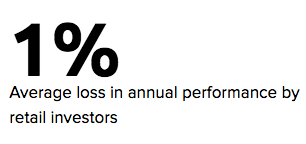Reblog: Why Our Emotions Ruin Investing Decisions
Listen to this article
Markets are at the whim of shocks and surprises. No doubt that last year’s surprising Brexit referendum result and Trump’s impressive presidential election win remind us of that. When it comes to taking risks, humans are not (necessarily) equipped to deal with the rollercoaster world of risks and investing in a level-headed way.
Humans Can Be Their Own Worst Enemies
Even the toughest of people get emotional. It is in our nature: by having feelings and emotions, we are prone to making mistakes and applying rational principles in a less than sensible way. The worlds of behavioural economics and psychology support this, identifying countless cases of humans making decisions based on emotions, rather than pure logic.
Some of these pitfalls include the likes of loss aversion, which is our disproportionate dislike of losing compared to seeking comparative gains, as well as the sunk cost fallacy, where our previous poor decisions sometimes impact our future ones more than they should. This is particularly poignant in the world of investing. Trillions of dollars, including ordinary people’s savings and pensions, are at risk, as investors and investment professionals also succumb to irrationality. So, how do we fix this?
The High Price Of Active Investing
Traditionally, we have turned to active investing with professional investment managers to help us delegate investment decisions. However, active investing, based on humans choosing how, where and in which asset classes to invest, is just as prone to emotional decision-making. We have long assumed that investment managers, with years of experience, would generate positive results, but from recent studies, we know the majority of active managers typically underperform compared to an index, such as the FTSE 100 or the S&P 500.
An interesting experiment run in 2009 by prolific investor Joel Greenblatt provides sobering insights into the capability of professional investors to create value. An algorithm he had developed, which he named the ‘Magic Formula,’ selected stocks for him and his business partner. Then, they actively tried to beat the algorithm’s performance by removing stocks they deemed to be overvalued. They lost to the algorithm.
The reason for the consistent underperformance of active fund managers, however, is not just their inability to create portfolios that outperform market indices, it is also related to the excessive cost of this approach. The issue has become a major conversation point within the industry in recent times, as the FCA has criticised active managers in their Asset Management Market study:
“Funds which are available to retail investors underperform their benchmarks after costs… Many active funds offer similar exposure to passive funds, but some charge significantly more”. tweet
Is Passive Investing The Solution?
Passive investing allows investors to take the costly fund managers out of the equation by just participating in the returns of an index through investment in index funds or Exchange Traded Funds (ETFs). This makes it significantly less expensive compared to active management.
However, passive management does not solve the critical question of how an investor should build his or her portfolio or, in other words, how much they should invest into what index and how their allocation should change over time. The trouble with DIY investing into passive instruments is that investors, again, need to make decisions themselves – not about which individual stocks or bonds to invest into, but about which markets and asset classes they should be investing in.
 Andrew Clare and Nick Motson of Cass Business School looked at retail investors’ performance in 2010. Their findings show that retail investors on average lost more than 1% in annual performance on their investments compared to a mere buy-and-hold strategy because they actively traded in and out of funds during the year (as shown in Figure 1). So, not only do algorithms perform better than humans, but actively adjusting a portfolio is detrimental to investment performance and also expensive.
Andrew Clare and Nick Motson of Cass Business School looked at retail investors’ performance in 2010. Their findings show that retail investors on average lost more than 1% in annual performance on their investments compared to a mere buy-and-hold strategy because they actively traded in and out of funds during the year (as shown in Figure 1). So, not only do algorithms perform better than humans, but actively adjusting a portfolio is detrimental to investment performance and also expensive.

Figure 1
2017: The Year Of Technology-Enabled Investing
The idea of letting computers and algorithms manage your money may seem very exciting to some, and to others, somewhat daunting. However, whether we are aware of it or not, we rely on algorithms and technology for something more important than our pensions and savings – our lives. Take aeroplanes, for example. It is common knowledge that pilots rely on the autopilot to fly the aircraft, particularly in difficult situations. The autopilot is quicker and better at making sense of complex data through its sensors and algorithms.
Scalable Capital is a UK-based digital investment manager who has already attracted more than £100m of client assets to manage, using a technology-driven investment approach. It uses a sophisticated data-driven investment model to determine a client’s initial portfolio allocation based on their risk tolerance. This portfolio is then automatically monitored and continually adjusted when required to keep risk constant, in all market conditions. A risk-based approach to investing has historically shown better performance than a portfolio with a static allocation (e.g. 60% stocks, 40% bonds), as a recent study from Yale University has found.
 Just like the pilots overseeing the technology in aeroplanes, Scalable Capital has experienced professionals from the likes of Goldman Sachs overseeing all trades and ensuring that the algorithm runs smoothly.
Just like the pilots overseeing the technology in aeroplanes, Scalable Capital has experienced professionals from the likes of Goldman Sachs overseeing all trades and ensuring that the algorithm runs smoothly.
Until now, technology-driven investment techniques have only been employed by the biggest financial institutions with their expensive computer mainframes optimising multibillion-dollar portfolios for institutional clients. Scalable Capital capitalises on the advent of cloud computing to put this sophisticated long-term investment strategy into the hands of retail investors at a fraction of the cost.
There is often talk of the value of human-to-human interaction in business. But, in some cases, technology is simply better placed to do the job. It has saved time and lives in sectors such as healthcare and transport. Perhaps it is time we let technology do the same with our money.
The original article is penned by Adam French and is available here.
Follow us on Twitter, Facebook, Instagram, Pinterest, Google+





